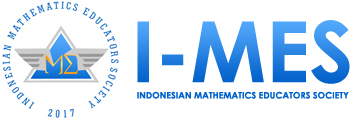Deskripsi Kemampuan Koneksi Matematis Siswa Kelas X Pada Materi Sistem Persamaan Linear Tiga Variabel
DOI:
https://doi.org/10.35706/sjme.v4i1.2026Abstract
Koneksi matematis merupakan salah satu dari 5 standar kemampuan dasar yang wajib dimiliki siswa dalam proses pembelajaran matematika. Banyak kajian-kajian yang menyatakan pentingnya pengembangan kemampuan ini bagi siswa. Oleh karena itu penelitian ini bertujuan untuk mengetahui bagaimana kemampuan koneksi matematis siswa Kelas X Ilmu-Ilmu Sosial (IIS). Untuk mendeskripsikan kemampuan koneksi matematis siswa Subjek penelitian ini adalah 34 siswa kelas X ilmu-ilmu sosial (IIS) SMA N 2 Banjarmasin. Hasil pekerjaan siswa dibagi dalam 3 kategori yakni, tinggi, sedang dan rendah. Selanjutnya dipilih 1 siswa dari masing-masing kategori dengan pertimbangan hasil pekerjaan subjek dapat mewakili hasil pekerjaan setiap kategori. Selanjutnya ketiga subjek terpilih diberikan soal tes. Dari hasil tes yang dilakukan kepada 3 orang siswa sebagai sampel, didapat bahwa subjek dengan kategori kemampuan rendah dan sedang belum memenuhi ketiga indikator koneksi matematis. Berbeda dengan subjek pada kategori tinggi yang telah memenuhi indikator ketiga namun belum memenuhi indikator lainnya.
Downloads
References
Aini, K. N. 2016. Proses Koneksi Matematis Siswa dalam Memecahkan Masalah Bangun Datar. Tesis Magister. Universitas Negeri Malang, Malang. Tidak dipubliksikan
Bergeson, T. (2000). Teaching and Learning Mathematics. https://doi.org/10.1086/442876
Bernard, M., & Senjayawati, E. (2019). Developing the Students’ Ability in Understanding Mathematics and Self-confidence with VBA for Excel. JRAMathEdu (Journal of Research and Advances in Mathematics Education), 1(1), 45–56. https://doi.org/10.23917/jramathedu.v1i1.6349
Bertolin, J. (2018). Higher Education and Development in the Knowledge Society. Higher Education for the Future, 5(2), 122–141. https://doi.org/10.1177/2347631118767279
Bhinnety, M. (2012). Struktur Dan Proses Memori. BULETIN PSIKOLOGI, 16(2), 74–88
Efriani, A., Hapizah, & Putri, R. I. I. (2019). Sailing Context In Pisa-Like Mathematics Problems. Journal on Mathematics Education, 10(2), 265–276
Haji, S., Abdullah, M. I., Maizora, S., & Yumiati, Y. (2017). Developing Students’ Ability Of Mathematical Connection Through Using Outdoor Mathematics Learning. Infinity Journal, 6(1), 11. https://doi.org/10.22460/infinity.v6i1.234
Harahap, H. . (2017). Penerapan Contextual Teaching And Learning Untuk Meningkatkan Kemampuan Koneksi Matematika Siswa . Jurnal MATEMATICS PAEDAGOGIC, 1(2), 152–161
Hemdriana, H., Slamet, A. ., & Sumarmo, U. (2014). MATHEMATICAL CONNECTION ABILITY AND SELF-CONFIDENCE (An experiment on Junior High School students through Contextual Teaching and learning with Mathematical Manipulative). International Journal of Education, 8(1), 1–11
King, A. (2014). Mathematical Explorations: Freshwater Scarcity A Proportional Representation. NCTM, 20(3), 152–157
Maulyda, M. A., Hidayanto, E., & Rahardjo, S. (2019). Representation of Trigonometry Graph Funcsion Colage Students Using GeoGebra. International Journal of Trends in Mathematics Education Research, 2(4), 1–7
Mhlolo, M. K., Venkat, H., & Schäfer, M. (2012). The nature and quality of the mathematical connections teachers make. Pythagoras, 33(1), 12–24. https://doi.org/10.4102/pythagoras.v33i1.22
Panasuk, R. M. (2010). Three Phase Ranking Framework for Assessing Conceptual Understanding in Algebra Using Multiple Representations. The Mathematics Educator, 131(2), 235–257
Plucker, J. A., & Beghetto, R. A. (2014). Why Creativity Is Domain General, Why It Looks Domain Specific, and Why the Distinction Does Not Matter. In Creativity: From potential to realization. (pp. 153–167). https://doi.org/10.1037/10692-009
Rohendi, D., & Dulpaja, J. (2013). Connected Mathematics Project (CMP) Model Based on Presentation Media to the Mathematical Connection Ability of Junior High School Student. Journal of Education and Practice, 4(4), 17–22
Rusmini, & Surya, E. (2017). The Effect of Contextual Learning Approach to Mathematical Connection Ability and Student SelfConfidence Grade Viii Smp Negeri 8 Medan. International Journal of Sciences: Basic and Applied Research (IJSBAR), 35(2), 249–262
Siregar, D. ., & Surya, E. (2017). Analysis of Students’ Junior High School Mathematical Connection Ability. International Journal of Sciences: Basic and Applied Research (IJSBAR), 33(2), 309–320
Tall, D., & Razali, M. R. (1993). Diagnosing students’ difficulties in learning mathematics. International Journal of Mathematical Education in Science and Technology, 24(2), 209–222. https://doi.org/10.1080/0020739930240206
Tello, E. A. (2010). Making Mathematics Word Problems Reliable Measures of Student Mathematics Abilities. Journal of Mathematics Education, 3(1), 15–26
The National Council of Teachers of Mathematics. (2000). Principles and Standards for School Mathematics. Reston, VA: The National Council of Teachers of Mathematics, Inc.
Downloads
Published
How to Cite
Issue
Section
License
Authors who publish with this journal agree to the following terms:
- Authors retain copyright and grant the journal right of first publication with the work simultaneously licensed under a Creative Commons Attribution License that allows others to share the work with an acknowledgment of the work's authorship and initial publication in this journal.
- Authors are able to enter into separate, additional contractual arrangements for the non-exclusive distribution of the journal's published version of the work (e.g., post it to an institutional repository or publish it in a book), with an acknowledgment of its initial publication in this journal.
- Authors are permitted and encouraged to post their work online (e.g., in institutional repositories or on their website) prior to and during the submission process, as it can lead to productive exchanges, as well as earlier and greater citation of published work (See The Effect of Open Access).












